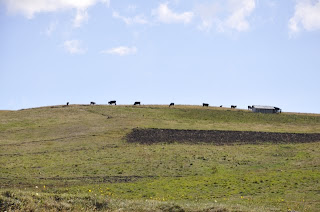We received such a positive response to our posting of A walk in town that we thought you might enjoy a similar drive up into the mountains beginning just outside Cuenca and on up into the Cajas National Park. Though only about 25% of our friends own a car, we chose to have a vehicle to take on weekend jaunts like this into the mountains, often just roaming the steep, dirt roads to soak up unique, out-of-the-way, Ecuadorian culture.
+start.bmp)
Above is a view from our apartment up into the Cajas National Park. After a short drive through town, past the cluster of high rise apartment buildings mainly occupied by the expat community, then up and on through one small village after another until we are in a beautiful, wild countryside.
From the road side, we couldn't resist taking a photo of these cattle sillouetted against the horizon.
Then around the next bend there were horses grazing on the lush straw grass
After about 20 km or so, a left turn off the highway and down a long, winding dirt road, passing many trout ponds and rushing streams, we arrive at our favorite restaurant, Dos Chorreros. We have spent many happy birthdays, Christmas days and holidays having dinner here on trout raised in their mountain stream fed ponds.
A view from the restaurant up into the higher country where there are almost no trees. The restaurant is at about 12,000 feet elevation.
After a huge dinner, we often hike up this narrow, gravel road past strange perpidicular trees called Puya Bromeliades, a hairy flowered spike surrounded by wool. Orange, licen covered rocks and wild flowers are everywhere. Though we are almost on the equator, at this altitude it can be cold enough that we usually wear parkas and hats. Back in Cuenca, 30 km away, people are in T-shirts. About 10 km beyond the restaurant, the highway comes to a control point where we enter the Cajas National Park
One day, we will find our way up to these waterfalls that tumble down from the high country. .
One of the 250 sparkling, clear lakes in the park that are favorite haunts for trout fishing. These lakes and the mountain rivers provide 60% of Cuenca's drinking water reputed to be the best in Ecuador.
Alpaca's roam the rocky terrain nibbling on the lush growth. The narrow road in the background from this point on heads down the west side of the Andes toward Guayaquil. It is actually the main road from Cuenca to Guayaquil followed by the busses and limos, a winding, harrowing trip for anyone. At this point we are on the Continental Divide where all the water on the west slope of the Andes falls to the Pacific Ocean and all the water on the East slope travels 1000 miles through the Amazon before emptying into the Atlantic Ocean.
Far above the tree line, the lunar landscape is like being in another world. Depending on where you go in the Cajas National Park, you will see barren, volcanic outcropings like this, cloud forests, farm land, grazing animals, hundreds of fishing lakes, waterfalls, and more in a constantly interesting panorama. Cajas is a natural wonderland worthy of deeper penetration than just a dive in the car.
+Bill+and+Loretta.bmp)



+restaurant+view.bmp)





No comments:
Post a Comment
Please leave a comment.